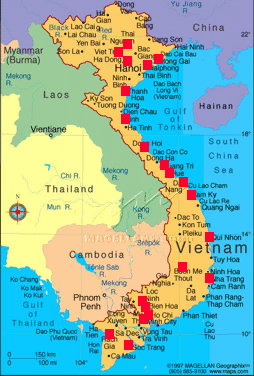 NASPE/BPEG code for
pacemakers.
NASPE/BPEG code for
pacemakers.
Typically only the first 4 letters are used. The fifth letter is only
used in the case of triple chamber devices, see CRT.
The pacemakers below are safe for MRI scanning. They
do require that the device be programmed to a safe program
prior to the scan, and then reprogrammed back to the original program.
These are the MR conditional pacemakers. This is the future trend for
pacemaker. It is estimated that a person being implanted today with a
pacemaker will likely need to undergo an MRI scan during the life of
the pacemaker. Without it being MR conditional, an MRI scan may be
refused, depriving the patient from a life saving diagnostic!
- ProMRI Evia
DR
(DDDR). This the premium pacemaker from Biotronik with its unique CLS
physiologic rate response that gives the patient a "normal" heart rate
(all the other devices use an accelerometer to determine your heart
rate, which is non-physiologic). When used with
a ProMRI lead, it is an MR
conditional pacemaker
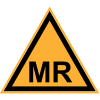 system. News features include: atrial autocapture, automatic
sensitivity (like in defibrillators), two algorithms to reduce
ventricular pacing, namely IRS+ and Vp Suppression, Program Consult
(for 10 default program sets), Easy AV (to simplify programming AV
delay and AV hysteresis), >12 years service life.
system. News features include: atrial autocapture, automatic
sensitivity (like in defibrillators), two algorithms to reduce
ventricular pacing, namely IRS+ and Vp Suppression, Program Consult
(for 10 default program sets), Easy AV (to simplify programming AV
delay and AV hysteresis), >12 years service life.
- ProMRI Estella
DR (DDDR). Almost everything in the Evia,
minus CLS. MR conditional, >12 years service life. The
affordable MR conditional DR.
- ProMRI Estella
SR (AAIR/VVIR). MR conditional, >15
years service life. The affordable MR conditional VR.
- Effecta
D (DDD). All the automation in the Estella DR,
>12 years service life.
- Effecta
S (AAI/VVI). >15 years
service life.
For MRI scanning, the
whole system (pacemaker and lead) must be MR conditional.
See below.
Why is MR conditional important. Below is a graph illustrating the
increased need for MRI diagnostics with increased age. Since implanting
a non MR conditional may be a verdict for the remaining life of no-MRI
(a non-MRI conditional lead in the body = no MRI), it is of the utmost
importance that only MR conditional systems be implanted.
For a young
patient, the
selection of a high quality lead may be even more critical than that of
the pacemaker. We offer one of industry's best longevity
lead. While
a pacemaker service life is 7-15 years, depending on
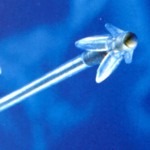
how it
operates, a high quality pacing lead can last 2 to 3
times as
long. This is important since most cardiologists will leave the lead in
the body should it become defective, clogging the vein of the patient.
The cumulative survival rate of the Polyrox lead that we have been
selling in Vietnam for a number of years is shown in the graph below.
None
of the competing leads in Vietnam can boast such survival rate.
Implantable
cardioverter-defibrillator
ICDs are
devices used to treat patients with life threatening fast heart rate,
namely ventricular fibrillation. We offer the following products:
 Implantable
cardioverter defibrillators Implantable
cardioverter defibrillators |
|
Single chamber |
Dual chamber |
Single lead dual chamber |
Triple chamber for Congestive Heart Failure Therapy |
Iforia 3,
11 mm thin |
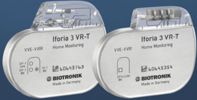 |
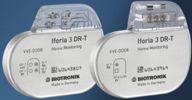 |
|
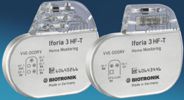 |
Iforia
3 VR-T
10,1 years |
Iforia
3 DR-T
9,0 years |
Iforia
3 HF-T
6,6 years |
| Devices
below are MR conditional (can have MRI) |
Iforia
5,
11 mm thin |
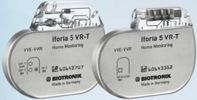
|
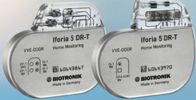
|
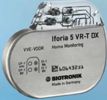 |
 |
Iforia 5 VR-T
10,1 years |
Iforia 5 DR-T
9,0 years |
Iforia
5 VR-T
DX,
9,2 years |
Iforia
5 HF-T
6,6 years |
Iforia
7,
11 mm thin |
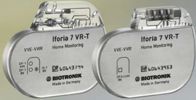
|
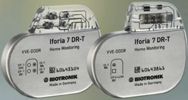
|
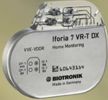 |
 |
Iforia
7 VR-T
11,5 years |
Iforia 7 DR-T
10,2 years |
Iforia
7 VR-T
DX,
10,5 years |
Iforia
7 HF-T
7,5 years |
All
the above devices provide ventricular tachyarrhythmia (fast
heart rhythm) therapy and either single, dual or triple
chamber bradycardia (slow heart rate, see pacemaker above) therapy.
The
main device is the Iforia 3 VR-T with a 1,52 Ah battery, larger than
most competitors. The Ifforia 3 DR-T is the dual
chamber ICD. The Iforia 3 HF-T is
the
triple chamber ICD, the CRT-D. These devices unfortunately
have a contraindications for MRI,
that is you cannot have an MRI once you have them in your body. This is
a common problem with all ICDs until recently.
Our
premium devices are the Iforia 5 and 7 ICDs which are MR
conditional
when used with MR conditional leads, namely the
Linox smart
ProMRI SD or Protego ProMRI SD shock lead and the Safio and Solia leads
(see above). Both Iforia 5 and 7 devices offer essentially the saem
functionality but the Iforia 7 ICDs have 1,73 Ah
batteries,
the largest available,
and excellent longevity.
All the Iforia ICDs are
11 mm thin and can provide shocks with a maximum energy of 40 Joules,
able to take care of all cases.
Except for the VR-T DX devices, all the other devices can be offered
for use with the traditional (IS-1 + DF-1) connector or the newer DF-4
connectors. Unlike our competitors you and your cardiologist have a
choice.
For
ICDs in the same
generation, i.e. the year of product introduction, Biotronik ICDs lead
others in the following
- Thickness.
Biotronik are typically thinner than others, only 11 mm.
- ATP-One-Shot therapy for the fastest rate lethal
ventricular arrythmia, ventricular fibrillation. If the rhythm is
stable, the device will deliver a painless bursts of pacing and
immediately start charging for a shock. In clinical studies,
ATP-One-Shot is successful in breaking over 2/3 of these episodes of
very rapid arrhythmia which in previous generations of defibrillators
would have been treated with painful shocks. According to the studies
done by Dr Sweeney, ATP-One-Shot can decrease your risk, since patients
who receive shocks tend to have a shorter life than those who don't.
- The largest memory available for storing electrograms. This
is a key diagnostic capability. 30 s of pre-episode electrogram can
help your
cardiologist adjust your medication to prevent recurrence of the
tachyarrhythmia episode. Length of electrogram helps understand the
progression of the arrhythmia during therapy progress and again helps
your cardiologist adjust the ICD parameters for optimal and less
painful therapy.
- Number of channels. VR-T DX, DR, HF-T: 3 channels. All
other: 2 channels.
- Duration: 24 minutes;
- Pre-storage: up to 30 s;
In
general dual chamber devices
are implanted because either the patient requires pacing due to slow
heart rate or because the patient has episodes of ventricular
tachycardia (an organized high rate ventricular rhythm that reduces
blood circulation and thus requires therapy). A single chamber device
has a high probability of misdiagnosing a supraventricular (above the
ventricle) tachyarrhythmia, which normally does not require therapy
because it
is typically not life threatening, for an episode of ventricular
tachycardia leading to therapy being delivered in the ventricle causing
pain
and possibly generating an episode of ventricular tachycardia or
ventricular fibrillation. All the Biotronik dual and triple chamber
ICDs use the
SMART Detection discrimination algorithm to prevent inappropriate
therapy from being delivered. This algorithm was developed by Dr. Tran
Thong, the founder of
Northwest
and
Systolic, and his
engineers at
Biotronik, and is currently the best
discrimination algorithm with sensitivity (ability to detect a
ventricular tachyarrhythmia) of 100%, and a specificity
(ability to hold off therapy when not a ventricular tachyarrhythmia) of
93-97%. A single chamber ICD typically has specificity in the 50-75%
range, thus delivers a lot of inappropriate therapies, especially
painful shocks, in patients with ventricular tachycardia! This is one
of the reasons why over half of the ICD implants in the US are dual
chamber devices! In the recent report on the
ALTITUDE study,
shock therapy of atrial fibrillation can increase your mortality risk
by 61%, when compared to no shock. Thus, you owe it to yourself to have
the best discrimination algorithm in your dual chamber defibrillator.
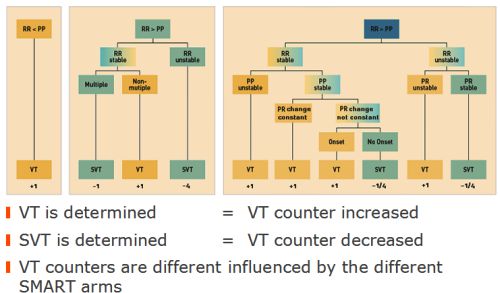 Smart Detection diagram.
Simple but very effective!
Smart Detection diagram.
Simple but very effective!
For
patients who require pacing, we highly recommend the dual chamber
Biotronik defibrillators above. All the Biotronik dual chamber
pacemakers and defibrillators support the IRS+ algorithm for reduced
ventricular pacing. This is similar to the algorithm used in the
INTRINSIC RV
clinical study which showed that dual chamber pacing with
an algorithm similar to IRS+ to reduce ventricular pacing can actually
reduce incidences of heart failure. In Vietnam, the reduction
demonstrated in INTRINSIC RV can only be achieved with Biotronik dual
chamber devices. The ventricular pace reduction algorithm used in all
the competing devices are different from the one in this study!
The
original shock lead used with
our
devices, the Kentrox SL, has an excellent survival record, still
unmatched by its competitor.

Kentrox
SL survival probability.
Extract from Biotronik performance
reports.
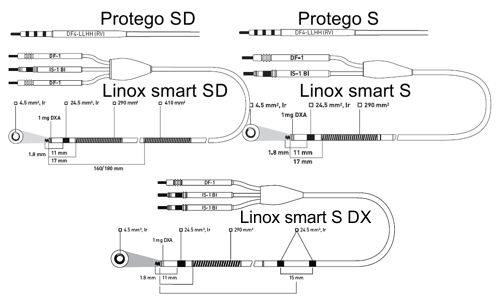
Linox
smart and Protego shock leads with screw fixation.
We can also offer the same leads with a passive fixation.
And we can also offer the ProMRI, MRI conditional,
versions of all the screw fixation shock leads.
Linox
smart and Protego shock leads
are the successors to the Kentrox. Requiring only an 8 French
introducer,
this is an extremely flexible lead with a soft lead tip designed to
minimized dammage to the heart, a problem that has plagged other leads.
To help cardiologists, the leads also has a smooth surface, SilGlide,
formed by plasma heating the silicone insultaion.
With its flat wire technology (ProTek) to minimize fibrosis, the lead
can be removed more easily should this become necessary at some time in
the future. It also has one of the thickest insulation making it the
safest lead in the industry.
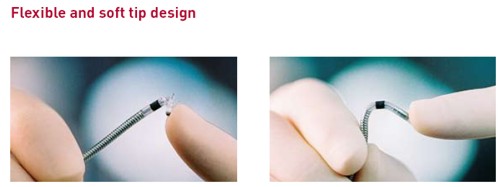
Linox
very flexible lead allows it to flex with each heart beat and not
dammage the heart.
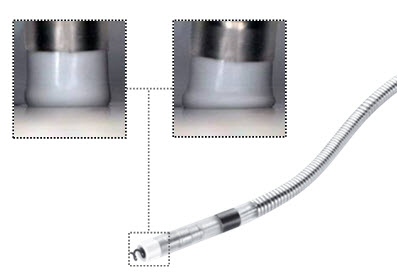
Linox soft tip reduces pressure
on the heart. It also help speed implant since the cardiologist can
make pacing measurements prior to deploying the screw.
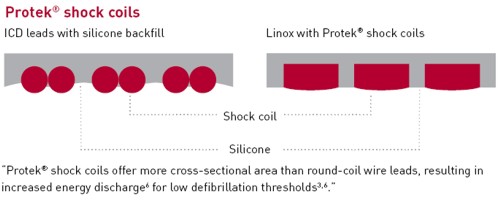

Protek design of all Biotronik
shock leads (already in Kentrox) increases energy delivery and
minimizes fibrosis, simplifying lead
removal should this become necessary.
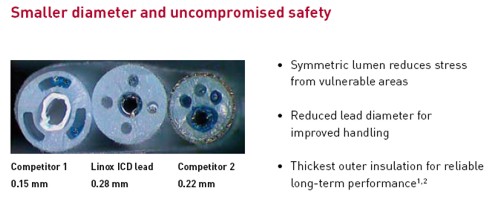
Insulation thickness. The lead on
the right has been recalled due to wire break and the company is now
supplying a much thicker lead. The lead on the left is no longer sold
due to insulation wear both from the outside and more seriously from
the
inside.
Why
play Russian
roulette with your defibrillation lead. Use the one that has
been the safest!
Home
Monitoring
A
new feature which has become available in Vietnam since mid 2011 is the
Biotronik Home Monitoring. In all of Southeast Asia, you can get Home
Monitoring (HM) only from Systolic Medical. All the Lumax family of
defibrillator are HM enabled. You will need to buy a CardioMessenger
(see picture above), a dedicated cellular phone that relays message
from your defibrillator to the monitoring center in Germany. Each night
the defibrillator transmit a full report of the functioning of the
device to the center. This is made available on the internet to the
monitor engineer of Systolic Medical, with >19 years of
experience with
Biotronik defibrillators. He will monitor everyday and if an event,
that you, the patient, may not even be aware of, happens, he will be in
contact with your designated cardiologist for a more detailed followup.
An example of a
patient with a history of significant arrhythmia that has been
successfully treated is available at this website. The page is in
Vietnamese, but just looking at the top graph, you can understand how
successful it has been. An another example is of predicting an imminent episode of heart failure
decompression, saving the patient from a hospital stay.
For non-Vietnamese patients, a defibrillator with Home Monitoring
is ideal. If you have been implanted a Biotronik defibrillator
in Southeast Asia, and Home Monitoring is not available
in your home country, you can come to Vietnam and we will
be glad to
set you up with it. As you are monitored, if an event is reported, your
personal cardiologist in your home country can be informed with
recommendation about what changes in programming would be required. If
interested, please contact us at nwspi@comcast.net.
Home
Monitoring just requires that at home you have access to a 3G cellular
network. Actually you need only the GPRS
capability of a 2.5G network. If you
have an iPhone and can surf the net, Home Monitoring will work.
We
now have a webpage dedicated to Home
Monitoring.
Cardiac
Resynchronization therapy
These
devices provide triple chamber pacing support for patients with
congestive heart failure with ventricular dissynchronization.
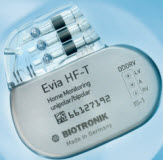 |
 |
 |
 |
| Evia HF-T |
Iforia
3 HF-T |
Iforia 5 HF-T |
Iforia 7 HF-T |
The
Evia HF-T
is a full featured triple chamber pacemaker, and the only MR
conditional in the world at this time (August 2012). The
Ioria 3/5/7 HF-T are a triple chamber ICDs. They all offer the
following key
features
- RV triggered pacing. When a right ventricular R wave is
sensed, a left ventricular pulse is triggered. The right ventricular
pulse is inhibited, saving battery.
- With the Evia HF-T the cardiologist has the ability to
select6 LV pacing vectors, 5 with the Iforias. This
enables the cardiologist to electronically reposition the LV lead to
try to avoid high pacing threshold, phrenic nerve stimulation (hiccup).
This particular feature has enabled us to successfully treat a patient.
The Evia HF-T is the latest
device from Biotronik. It is a triple chamber pacemaker that is MR
conditional when used with MR conditional leads, namely the Corox
ProMRI OTW and Corox ProMRI OTW-S (outwardly identical to the Corox OTW
and Corox OTW-S described below) and the Safio and Solia leads. It has
a number of very attractive features
- first and foremost is the physiological rate adaptation
CLS. The only rate adaptation that just increases the heart rate in
response to the body's hemodynamic needs, whether physical or mental!
CLS has also been shown to reduce the atrial fibrillation burden (the
time in AF). and can be used to overcome fainting due to position
change (vasovagal syncope).
- To optimize its longevity, it offers automatic adaptation
of the pacing voltages in all 3 chambers of the heart. Estimated
longevity is 8.8 years
- Implanting a left ventricular lead is a most challenging
task for the implanting cardiologist. As a result, it is desirable to
be able to adjust the LV pacing vector as much as possible. The Evia
HF-T offers 6 pacing vectors, the most of any device.
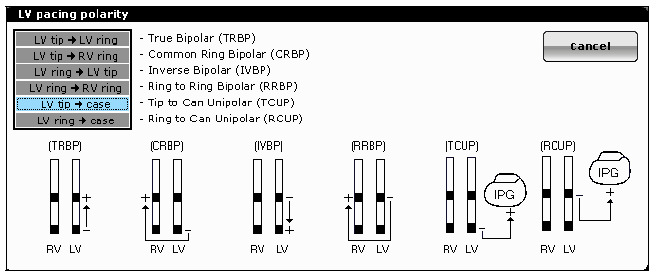
- Thoracic
impedance is measured a number of times a day to help the cardiologist
predict an imminent heart failure decompression which is characterized
by an accumulation of fluid in the lungs. In order to be able to
predict an acute episode, Home Monitoring
is needed.
If you are in the early stage of heart failure with a QRS width
>
150 ms, you may want to consider implanting an Evia HF-T system. Recent
clinical studies have shown that early intervention can halt and
reverse the progression of heart failure. If you are still young,
<85 years, an MR conditional system will allow you to be MRIed,
should it ever become necessary. So, don't take a chance, get a
completely MR conditional CRT system!

For the
left
atrial lead, we offer a range of Corox ProMRI bipolar lead.
The
Corrox ProMRI OTW with its unique 3D
spiral shape to
adhere securely to medium to small coronary veins. A new addition,
appropriate for
patients with small veins, is the -S version shown below, with a
silicone screw thread at the far end. The -L patient is suited for
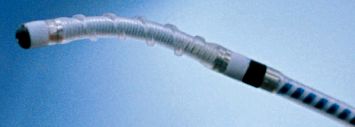
medium
coronary vein. All the Corox ProMRI leads have two electrodes. For very
small
to medium veins, there is also the Sentus unipolar
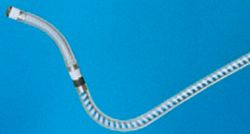
(not
MR conditional) lead
(below).

Please visit separate page using the link in the title.
For
our visitors from Cambodia and Laos

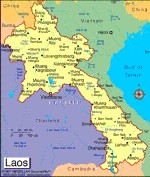
A clinic in
Phnom-Penh is implanting single chamber devices. We have
a large number of customers who have come to Vietnam from Laos and
Cambodia for device implant. If you have a cardiac rhythm problem and
believe you need to implant a device and would like to come to Vietnam,
we can make arrangements for you to be examined by a Vietnamese
cardiologist and to receive an implant, if needed. The Biotronik
devices have a worldwide warranty. The cost of Vietnamese care is
less than what it would cost you in Singapore or Thailand. Please feel
free to contact us at
nwspi@comcast.net
For
our visitors from the US
The
US is one of the few major
countries without universal

health insurance. If you are a
US resident, in particular a Vietnamese-American, not covered
by medical
insurance and have been diagnosed
to need a pacemaker/defibrillator implant, the alternative
to an expensive US procedure is to come back for a vacation to Vietnam
and have a Vietnamese cardiologist examine you and if needed, implant a
device. The cost of the trip, the exams and implant of a top of the
line pacemaker, for example the Evia DR,
is significantly
less than
what a basic device alone would cost you in the US. Andit is also MR
conditional, which means that you can have an MRI scan (In the US, this
should be feasible as of May 2014) If you need a defibrillator, an
Iforia 7 with Home Monitoring is the best system you can get
anywhere in the world. High marketing cost in the US is the
cause for the high implant cost in the US, on top of medical
malpractice insurances. The Biotronik
devices
have a worldwide warranty and can be followed at US clinics,
if needed. If you have a need for such a device, please feel free to
contact us at
nwspi@comcast.net
and
we can provide you with the introduction to a Vietnamese
hospital close to where your relatives/friends live in Vietnam. If you
prefer to stay at one of the excellent private clinics, and the clinic
does not have the appropriate cardiologist on their staff, we can make
arrangements for you to have an experienced cardiologist from a nearby
implanting hospital come and perform the implant, and follow you during
your
stay. Follow-ups in the US and Europe are not a problem since a
number of our patients in Vietnam have emigrated to the US and Europe
and they have not experienced any problem having their devices
monitored at
US and European clinics.
If you already have a US cardiologist, you can still come to Vietnam
for the implant of a defibrillator or triple chamber device, and then
visit your local cardiologist for any needed
follow-up. Your cardiologist should have the equipment provided by
Biotronik to perform any needed follow-up. Again, the total cost of the
implant of these advanced devices is significantly lower in Vietnam. An
estimate, about 5 years ago, for the implant cost of a basic single
chamber defibrillator in the US ranges from USD100K to USD150K. For
that amount, you can afford to have a top of the line defibrillator
implanted in Vietnam, for example the Iforia 7 DR-T or, in the case of
heart failure, an Iforia 7 HF-T the latest
Biotronik dual/triple chamber ICDs, with
Home
Monitoring and then
fly back to
Vietnam every 3-6 month for
follow-up, and still have cash left over!
The
most expensive devices are normally not stocked in Vietnam. But we can
have them on a week's notice directly from Biotronik.
Medical
Tourism
Found
the following article recently. It quotes a pacemaker implant costing
$7,500 in Bangkok, versus $83,600 in the US. For $7.500 you can get the
MR conditional Evia DR implanted AND have a nice vacation in
Vietnam! So, try Saigon, not
Bangkok! And if you want absolute peace of mind, implant an Evia DR-T
with Home Monitoring! You cannot get such a system in Bangkok because
Home Monitoring is not available in Thailand. The Home Monitoring
system will continue working once you get back to the US, or for that
matter anywhere in the world where your iPhone works.
We
can make arrangements for you to stay at a comfortable private clinic
and we will invite the best implanter to come to the hospital to
implant
the device. In a couple of days time, you can be off to some beach to
spend the rest of your vacation.
Sick?
Find your doctor, then call a travel agent
Published Thursday, August 13, 2009
To the gentleman who listed his ailments of the past four years and
anyone interested in health care, mainly the underinsured and uninsured
population, please read the article, "Need Surgery? Call a Travel
Agent," in the October 2008 issue of Men's Health magazine (www.menshealth.com).Type the name of the
article in the search box, and you should be able to click on the
five-page article.
Medical tourism patient costs are lower mainly because of hospital
labor costs, administrative costs and malpractice costs.
Payments essentially are cash only at a Bangkok hospital, with health
insurance being less than 15 percent. The hospital is the busiest in
the world, with labor representing 17 percent of hospital revenue. In
the U.S., it is almost 50 percent. In 2007, doctors treated 420,000
foreign patients from 190 nations. Among the 900 doctors, 200 are
U.S.-board certified.
Ready for the bill? Here are some medical tourism treatments and
prices:lumbar disc excision, $7,500, Mexico and $37,500, U.S.;
angioplasty, $8,200, Bangkok and $45,200, U.S.; new knee, $6,500 India
and $39,800, U.S.; spinal fuse, $13,500, India and$59,100, U.S.; new
hip, $6,500, India and $42,400, U.S.; coronary-artery bypass, $8,500,
India and $96,400, U.S.; and cardiac pacemaker, $7,500, Bangkok and
$83,600, U.S.
Medical tourism generally involves better care, price, recovery and
lower infection rate than the U.S.
Mexico anyone?
From John Connel, Medical
Tourism, CABI International, Oxfordshire, UK, 2011.

For 6,000 USD, you can
get an Evia DR which is MR conditional, not just
a single chamber device as seemed to be implied in the above table for
India. For a total
bill of <10,000 USD you can get the high end devices and have a
nice
vacation that has saved you >50,000 USD.
And if you want the latest
generation of products, India is not
necessarily the place to get them. In 2013 the latest Biotronik
generation of ICDs, the Iforia ICDs, was introduced. You would think
that India would be one of the first places in Asia to get the first
implant of Iforias. You are wrong! Here are some dates
- The first Iforia 3 HF-T was implanted in Vietnam on the
22nd of
July 2013,
- The first MR conditional Iforia 5 VR-T with DF-4 connector
was
implanted in Vietnam on the 12th of August 2013
- The first Iforia
DF-4 was implanted in India the week of September 16, 2013,
close to 2 months after we introduced the Iforia's in Vietnam.
Systolic
Medical Products
Systolic
Medical Products Import-Export Limited (Công ty
trách nhiệm hữu hạn
xuất nhập khẩu trang thiết bị y-tế Tâm Thu) is currently the largest
supplier
of cardiac rhythm
management products in Vietnam. Our main implant centers are in Hanoi,
Hue, Hochiminh City. We got to our current dominant position by
providing
- outstanding
service to our customers. For example this extensive website with over
a Gigabyte of materials to help Vietnamese customers understand the
underlying disease, the treatment and the therapeutic devices
available. Literature is available in Vietnamese, and other languages
upon request, to patients to explain the function of the device and how
the patients should care for the implanted devices. Our competitors
have copied our literature, but cannot match the information provided
at our website.
- and outstanding
support to implanting cardiologist with frequent training seminars and
consultation whenever needed. In
March
2008, we just finished a series of 3 training
workshops
in Hanoi, Hue, Hochiminh City to train cardiologists on the programming
of our devices. Without the knowledge to program the devices,
a top of the line device may be no better than a basic device! Dr. Tran
Thong, who led the pacemaker and defibrillator design team of
Biotronik, and now is a Professor of Biomedical Engineering researching
heart rhythm, is available to Vietnamese cardiologists for consultation
should they have any question on the devices implanted. Since he has
given many seminars over the past 16 years (since 1995) delivered in
Vietnamese,
unlike support from other companies that is provided in English,
language is no barrier for him when Vietnamese implanting cardiologists
encounter a problem with an implant. No other
supplier provides such support for
Vietnamese cardiologists.
So,
you owe it to yourself and your health to deal with the best!
Our
pacemaker implant centers in Vietnam are located at hospitals in the
following cities, going from North to South,
- Hanoi
- Haiphong
- Thanh Hoa
- Vinh
- Hue
- Danang
- Quy Nhon
- Buon Ma Thuot
- Nha Trang
- Bien Hoa
- Hochiminh City
- Rach Gia
We have a couple of private and semi-public hospitals in Hochiminh
City we will recommend based on their implant skills (we rate them very
high) and patient service (average - still some of the best in
Vietnam). Please contact us if interested. For emergency, contact us
for the nearest hospitals.






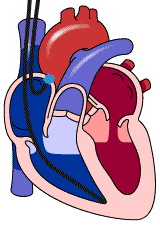

 system. News features include: atrial autocapture, automatic
sensitivity (like in defibrillators), two algorithms to reduce
ventricular pacing, namely IRS+ and Vp Suppression, Program Consult
(for 10 default program sets), Easy AV (to simplify programming AV
delay and AV hysteresis), >12 years service life.
system. News features include: atrial autocapture, automatic
sensitivity (like in defibrillators), two algorithms to reduce
ventricular pacing, namely IRS+ and Vp Suppression, Program Consult
(for 10 default program sets), Easy AV (to simplify programming AV
delay and AV hysteresis), >12 years service life. how it
operates, a high quality pacing lead can last 2 to 3
times as
long. This is important since most cardiologists will leave the lead in
the body should it become defective, clogging the vein of the patient.
The cumulative survival rate of the Polyrox lead that we have been
selling in Vietnam for a number of years is shown in the graph below.
None
of the competing leads in Vietnam can boast such survival rate.
how it
operates, a high quality pacing lead can last 2 to 3
times as
long. This is important since most cardiologists will leave the lead in
the body should it become defective, clogging the vein of the patient.
The cumulative survival rate of the Polyrox lead that we have been
selling in Vietnam for a number of years is shown in the graph below.
None
of the competing leads in Vietnam can boast such survival rate.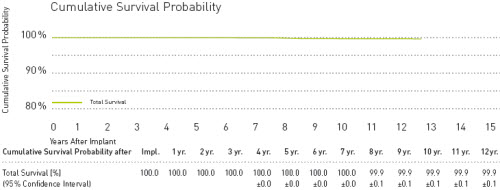
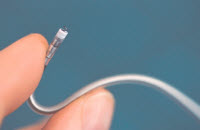
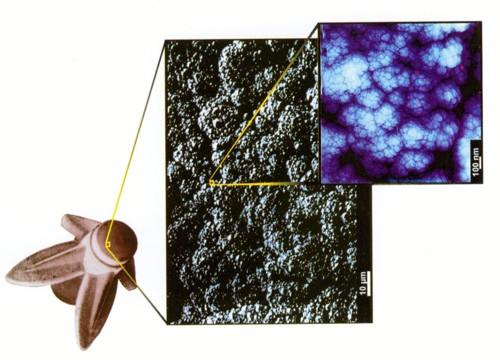
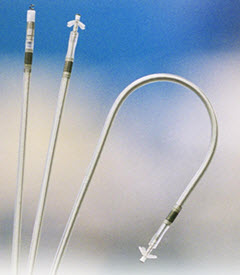 Siello S,
T and JT. This is the latest
generation of leads which require
6 French introducers. In spite of its smaller diameter, the insulation
thickness of the Siello lead is the same as the one of the Setrox lead
and the bigger Selox SR lead,
thus ensuring that this is a safe lead resistant to wear and tear.
Siello S,
T and JT. This is the latest
generation of leads which require
6 French introducers. In spite of its smaller diameter, the insulation
thickness of the Siello lead is the same as the one of the Setrox lead
and the bigger Selox SR lead,
thus ensuring that this is a safe lead resistant to wear and tear.
 Implantable
cardioverter defibrillators
Implantable
cardioverter defibrillators
























 For the
left
atrial lead, we offer a range of Corox ProMRI bipolar lead.
The
Corrox ProMRI OTW with its unique 3D
spiral shape to
adhere securely to medium to small coronary veins. A new addition,
appropriate for
patients with small veins, is the -S version shown below, with a
silicone screw thread at the far end. The -L patient is suited for
For the
left
atrial lead, we offer a range of Corox ProMRI bipolar lead.
The
Corrox ProMRI OTW with its unique 3D
spiral shape to
adhere securely to medium to small coronary veins. A new addition,
appropriate for
patients with small veins, is the -S version shown below, with a
silicone screw thread at the far end. The -L patient is suited for  medium
coronary vein. All the Corox ProMRI leads have two electrodes. For very
small
to medium veins, there is also the Sentus unipolar
medium
coronary vein. All the Corox ProMRI leads have two electrodes. For very
small
to medium veins, there is also the Sentus unipolar  (not
MR conditional) lead
(below).
(not
MR conditional) lead
(below).

 A clinic in
Phnom-Penh is implanting single chamber devices. We have
a large number of customers who have come to Vietnam from Laos and
Cambodia for device implant. If you have a cardiac rhythm problem and
believe you need to implant a device and would like to come to Vietnam,
we can make arrangements for you to be examined by a Vietnamese
cardiologist and to receive an implant, if needed. The Biotronik
devices have a worldwide warranty. The cost of Vietnamese care is
less than what it would cost you in Singapore or Thailand. Please feel
free to contact us at nwspi@comcast.net
A clinic in
Phnom-Penh is implanting single chamber devices. We have
a large number of customers who have come to Vietnam from Laos and
Cambodia for device implant. If you have a cardiac rhythm problem and
believe you need to implant a device and would like to come to Vietnam,
we can make arrangements for you to be examined by a Vietnamese
cardiologist and to receive an implant, if needed. The Biotronik
devices have a worldwide warranty. The cost of Vietnamese care is
less than what it would cost you in Singapore or Thailand. Please feel
free to contact us at nwspi@comcast.net
 health insurance. If you are a
US resident, in particular a Vietnamese-American, not covered
by medical
insurance and have been diagnosed
to need a pacemaker/defibrillator implant, the alternative
to an expensive US procedure is to come back for a vacation to Vietnam
and have a Vietnamese cardiologist examine you and if needed, implant a
device. The cost of the trip, the exams and implant of a top of the
line pacemaker, for example the Evia DR,
is significantly
less than
what a basic device alone would cost you in the US. Andit is also MR
conditional, which means that you can have an MRI scan (In the US, this
should be feasible as of May 2014) If you need a defibrillator, an
Iforia 7 with Home Monitoring is the best system you can get
anywhere in the world. High marketing cost in the US is the
cause for the high implant cost in the US, on top of medical
malpractice insurances. The Biotronik
devices
have a worldwide warranty and can be followed at US clinics,
if needed. If you have a need for such a device, please feel free to
contact us at nwspi@comcast.net
and
we can provide you with the introduction to a Vietnamese
hospital close to where your relatives/friends live in Vietnam. If you
prefer to stay at one of the excellent private clinics, and the clinic
does not have the appropriate cardiologist on their staff, we can make
arrangements for you to have an experienced cardiologist from a nearby
implanting hospital come and perform the implant, and follow you during
your
stay. Follow-ups in the US and Europe are not a problem since a
number of our patients in Vietnam have emigrated to the US and Europe
and they have not experienced any problem having their devices
monitored at
US and European clinics.
health insurance. If you are a
US resident, in particular a Vietnamese-American, not covered
by medical
insurance and have been diagnosed
to need a pacemaker/defibrillator implant, the alternative
to an expensive US procedure is to come back for a vacation to Vietnam
and have a Vietnamese cardiologist examine you and if needed, implant a
device. The cost of the trip, the exams and implant of a top of the
line pacemaker, for example the Evia DR,
is significantly
less than
what a basic device alone would cost you in the US. Andit is also MR
conditional, which means that you can have an MRI scan (In the US, this
should be feasible as of May 2014) If you need a defibrillator, an
Iforia 7 with Home Monitoring is the best system you can get
anywhere in the world. High marketing cost in the US is the
cause for the high implant cost in the US, on top of medical
malpractice insurances. The Biotronik
devices
have a worldwide warranty and can be followed at US clinics,
if needed. If you have a need for such a device, please feel free to
contact us at nwspi@comcast.net
and
we can provide you with the introduction to a Vietnamese
hospital close to where your relatives/friends live in Vietnam. If you
prefer to stay at one of the excellent private clinics, and the clinic
does not have the appropriate cardiologist on their staff, we can make
arrangements for you to have an experienced cardiologist from a nearby
implanting hospital come and perform the implant, and follow you during
your
stay. Follow-ups in the US and Europe are not a problem since a
number of our patients in Vietnam have emigrated to the US and Europe
and they have not experienced any problem having their devices
monitored at
US and European clinics.

